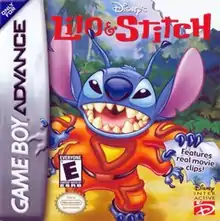Disney's Lilo & Stitch (Game Boy Advance video game)
Disney's Lilo & Stitch is a 2002 side-scrolling platform video game developed by Digital Eclipse for the Game Boy Advance that is based on the Disney animated film of the same name. It was first released in North America on June 7, 2002 by Disney Interactive. Ubisoft distributed the game in Europe on October 4, 2002, and in Australia on March 24, 2005.
| Disney's Lilo & Stitch | |
|---|---|
 North American box art | |
| Developer(s) | Digital Eclipse |
| Publisher(s) |
|
| Director(s) | Michael Mika Sr. |
| Artist(s) | Arvin Bautista |
| Composer(s) | Robert Baffy |
| Series | Lilo & Stitch |
| Platform(s) | Game Boy Advance |
| Release | |
| Genre(s) | Platform, run and gun, stealth, tube shooter |
| Mode(s) | Single-player |
Gameplay
The game takes place at an unknown point of time after the original film. An extraterrestrial bounty hunter kidnaps Lilo (vocal effects by Daveigh Chase) and brings her aboard the spaceship laboratory of a robotic, mosquito-like alien named Dr. Pestus, who plans to use her as food for his genetically-modified mosquito army. Stitch (vocal effects by Chris Sanders) must go out into space to rescue Lilo and defeat Dr. Pestus. In most levels, the player takes control of a four-armed, plasma blaster-wielding Stitch who must run and gun his way past enemies and various other obstacles to complete the level. He can also acquire special ammunition for his plasma blasters that allow him to fire more powerful plasma blasts and can acquire pineapple bombs to throw at enemies. In a couple puzzle-platform-styled levels, the player takes control of Lilo as she sneaks around the spaceship to find a way to escape and contact Stitch. In a couple tube shooter-styled segments, Stitch must fly a spaceship to reach the next level, shooting down other enemy ships and dodging obstacles along the way.
Reception
| Aggregator | Score |
|---|---|
| GameRankings | 75.58%[4] |
| Metacritic | 80/100[3] |
| Publication | Score |
|---|---|
| AllGame | |
| Game Informer | 8/10[5] |
| GamePro | |
| GameZone | 8.9/10[7] |
| IGN | 8/10[2] |
| Nintendo Power | 3.7/5[8] |
| Play |
Disney's Lilo & Stitch was met with mostly positive reviews, with critics favorably comparing the game to SNK's Metal Slug series,[6][2] but criticizing Stitch's inability to shoot while crawling or crouching[7][2] and the game's use of a password save system.[2] Critics also expressed concern that the game's high difficulty would frustrate its intended audience of young players.[6][7] GameRankings and Metacritic gave the game aggregated review scores of 75.58% and 80 out of 100, respectively.[4][3]
Sales
In the United States, the game sold 620,000 copies and earned $14 million by August 2006. During the period between January 2000 and August 2006, it was the 46th highest-selling game launched for the Game Boy Advance, Nintendo DS or PlayStation Portable in that country.[10]
Sequel
In 2004, Disney Interactive released a standalone sequel developed by Climax Studios titled Lilo & Stitch 2: Hämsterviel Havoc, which is based on Lilo & Stitch: The Series.
References
- Beam, Jennifer. "Disney's Lilo & Stitch (GBA) - Review". AllGame. Archived from the original on November 13, 2014. Retrieved October 22, 2014.
- Harris, Craig (June 13, 2002). "Disney's Lilo & Stitch (GBA)". IGN. Archived from the original on October 22, 2014. Retrieved October 22, 2014.
- "Disney's Lilo & Stitch for Game Boy Advance Reviews". Metacritic. Archived from the original on November 24, 2014. Retrieved October 22, 2014.
- "Disney's Lilo & Stitch for Game Boy Advance". GameRankings. Archived from the original on October 22, 2014. Retrieved October 22, 2014.
- Brogger, Kristian (August 2002). "Disney's Lilo and Stitch (GBA)". Game Informer (112): 91. Archived from the original on July 30, 2009. Retrieved October 22, 2014.
- Miss Spell (June 11, 2002). "Lilo and Stitch Review for Game Boy Advance on GamePro.com". GamePro. Archived from the original on January 22, 2005. Retrieved October 22, 2014.
- Hollingshead, Anise (June 19, 2002). "Disney's Lilo & Stitch - GBA - Review". GameZone. Archived from the original on February 24, 2009. Retrieved October 22, 2014.
- "Disney's Lilo & Stitch". Nintendo Power. 159: 146. August 2002.
- "Advance Notice - Lilo & Stitch". Play. No. 8. Fusion Publishing. August 2000. p. 76.
- Keiser, Joe (August 2, 2006). "The Century's Top 50 Handheld Games". Next Generation. Archived from the original on October 10, 2007.